Chemistry, Raman Spectroscopy and Micro-Textures of Theophrastite and Other Ni-Minerals from the Vermion Fe-Ni-Laterites, Greece: Genetic Significance
Abstract
1. Introduction
2. Geological Outline
3. Materials and Methods
4. Mineralogical Characteristics

| Figure 2c | ||||||||||||||||
|---|---|---|---|---|---|---|---|---|---|---|---|---|---|---|---|---|
| Ves | Srp | Ni-Srp | Tph | |||||||||||||
| wt.% | 1 | 2 | 2b | 3 | 3 | 3b | 3b | 3b | 4 | 4b | 4b | 4b | 4b | 5b | 5b | |
| SiO2 | 37.2 | 40.4 | 36.3 | 31.2 | 20.2 | 18.5 | 13.0 | 15.5 | 0.8 | 23.8 | 27.6 | 28.4 | 25.2 | 27.5 | n.d. | n.d. |
| MgO | 2.2 | 36.1 | 21.0 | 22.1 | n.d. | n.d. | n.d | n.d. | n.d. | n.d. | n.d. | n.d. | n.d | n.d | 1.2 | n.d. |
| NiO | n.d. | 3.2 | 23.9 | 17.2 | 59.7 | 61.0 | 61.5 | 61.3 | 66.2 | 55.9 | 51.0 | 53.1 | 50.5 | 51.9 | 47.7 | 46.9 |
| CaO | 35.2 | n.d | n.d | 0.2 | 0.2 | 0.3 | 0.2 | 0.2 | n.d. | 0.3 | 0.3 | 0.3 | 0.2 | 0.3 | n.d. | 0.1 |
| Fe2O3 | 3.6 | 1.6 | n.d | n.d | n.d. | n.d. | n.d | n.d. | 1.5 | n.d. | n.d. | 0.2 | n.d | n.d | n.d. | 0.2 |
| Cr2O3 | 0.4 | n.d | 0.11 | n.d | 0.1 | 0.3 | 0.1 | 0.2 | n.d. | 0.2 | 0.2 | n.d. | 0.2 | 0.2 | n.d. | n.d. |
| Al2O3 | 17.2 | 1.6 | n.d. | n.d | n.d. | n.d. | n.d | n.d. | n.d. | n.d. | n.d. | n.d. | n.d | n.d | n.d. | n.d. |
| Total | 95.8 | 82.9 | 81.3 | 70.7 | 80.2 | 80.1 | 74.8 | 77.2 | 68.5 | 80.2 | 79.1 | 82.0 | 76.1 | 79.9 | 48.9 | 47.2 |
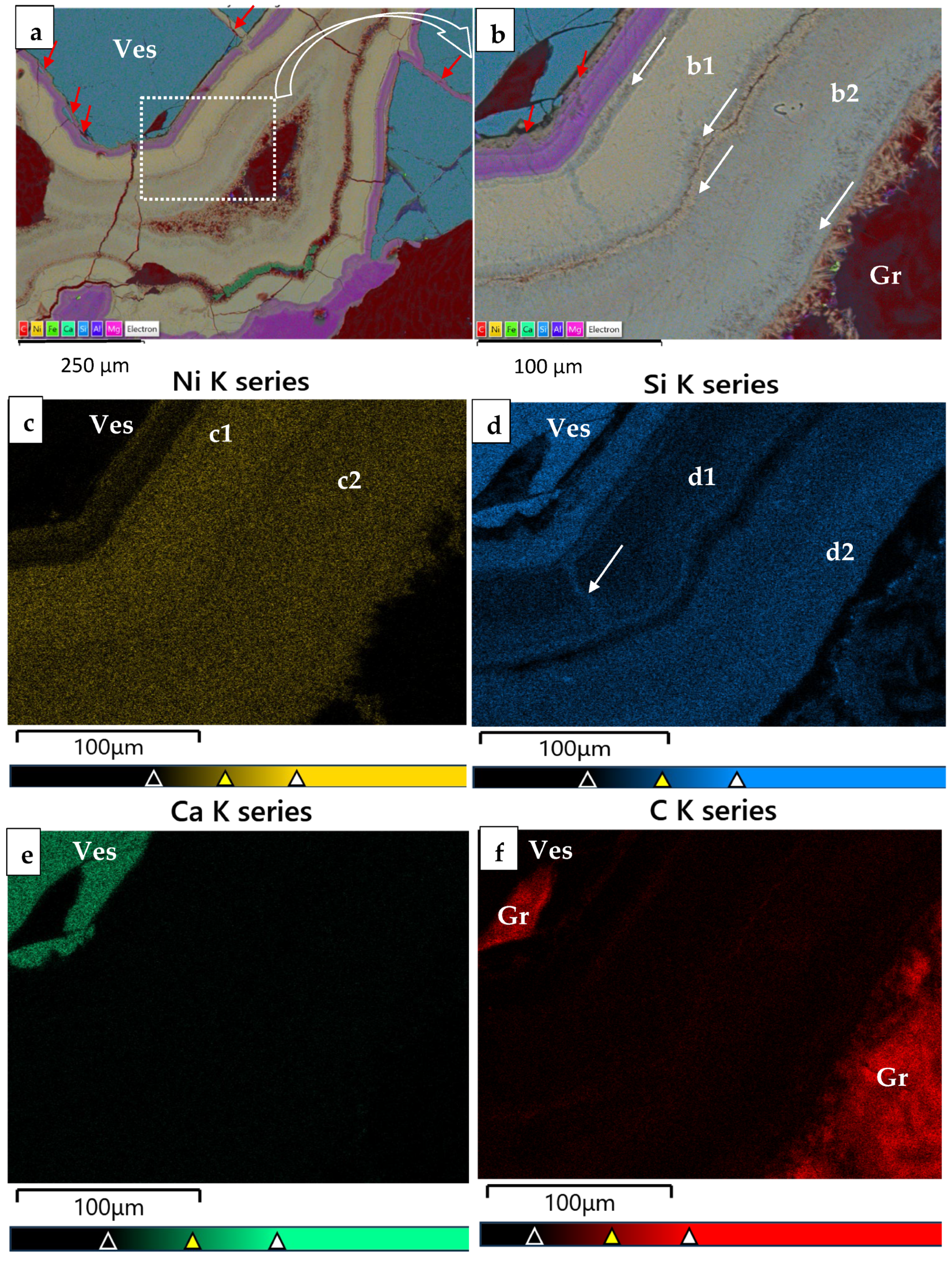
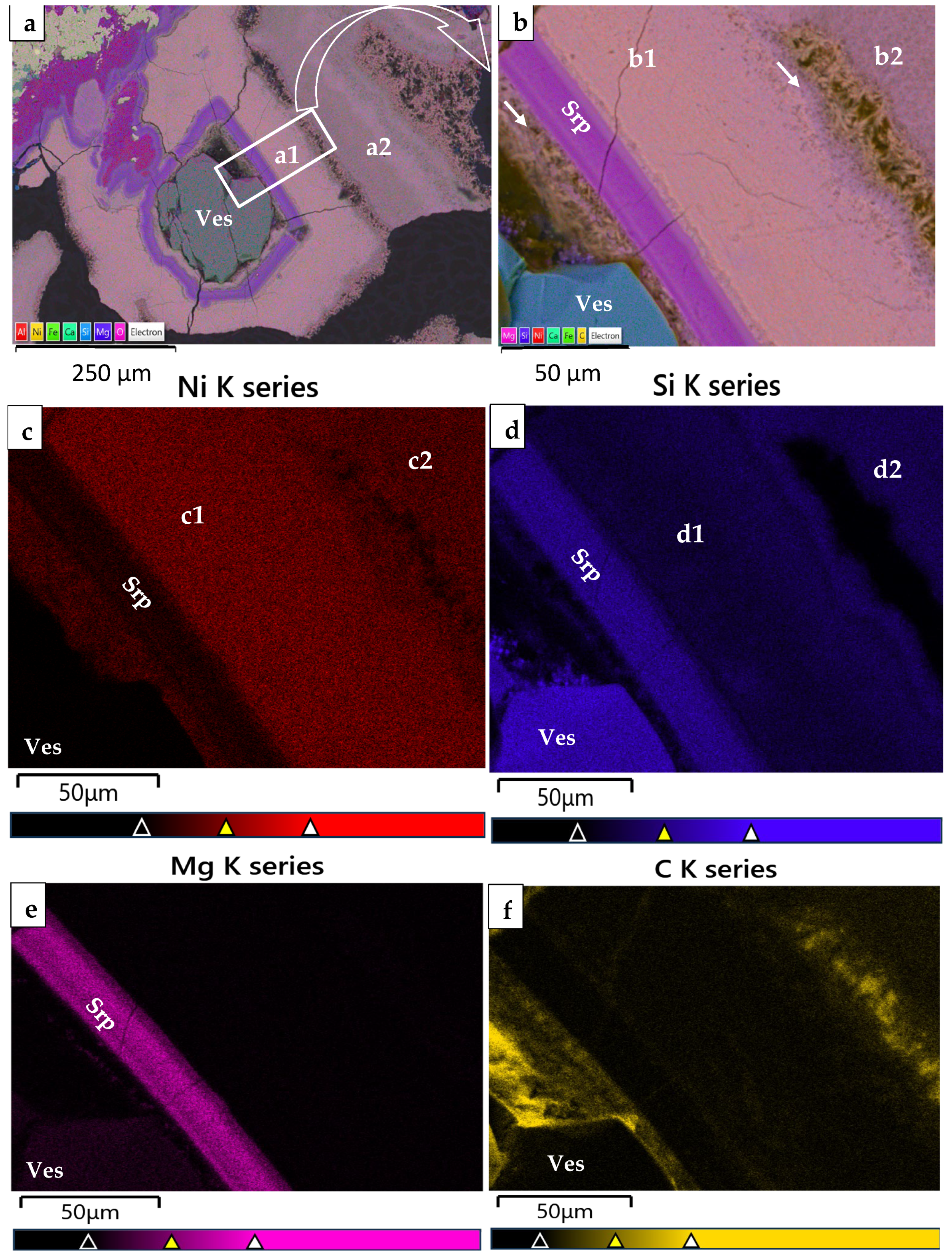
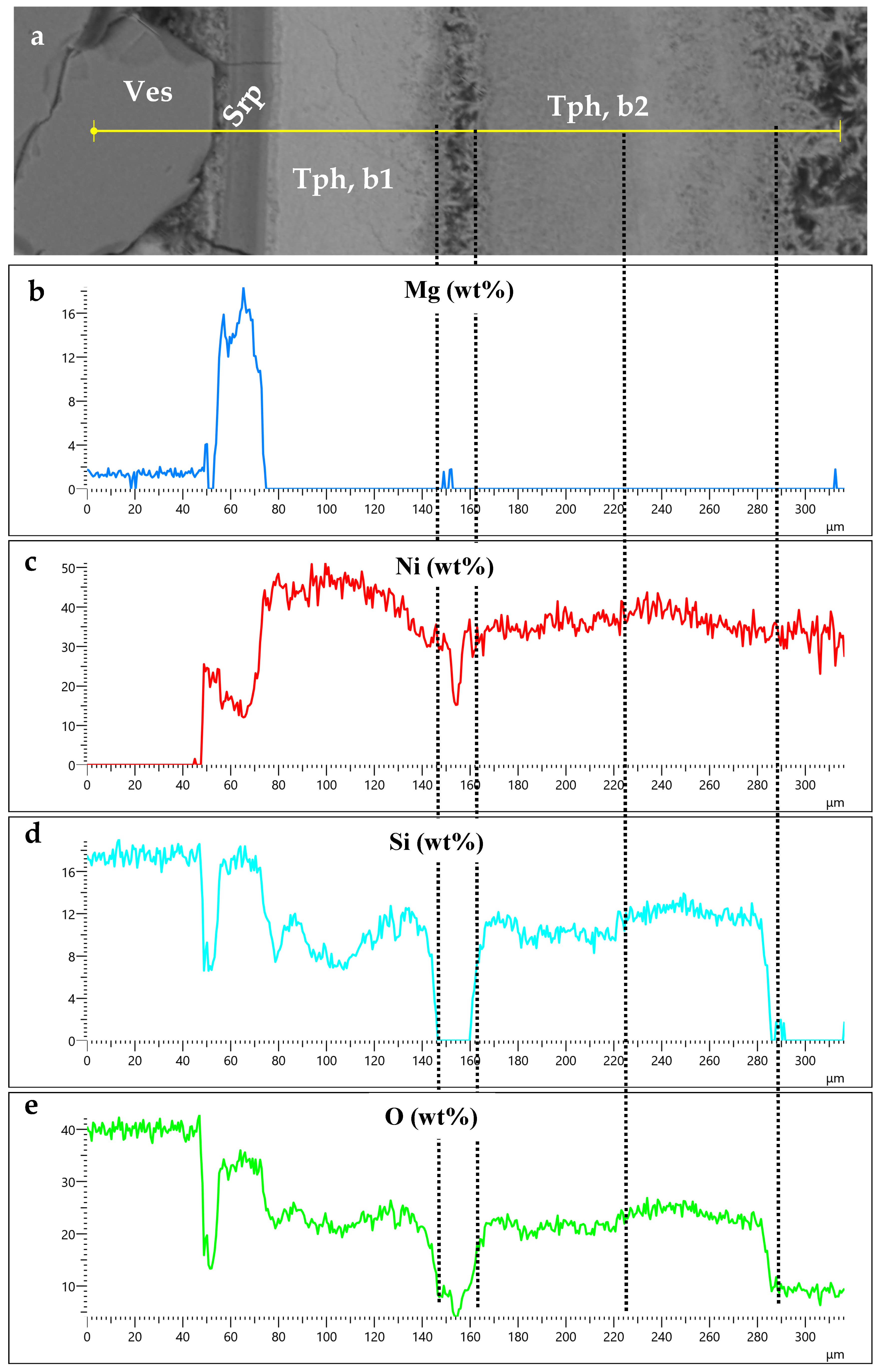

| Figure 6e | Figure 6a | Figure 6c | Figure 6f | Figure 6e | ||||||||||
|---|---|---|---|---|---|---|---|---|---|---|---|---|---|---|
| 1 | 2 | 3 | 4 | 5 | 6 | 7 | 8 | 9 | 10 | 11 | 12 | 13 | ||
| wt.% | Grt | Chl | Srp | Ni-Srp | (Ni, Co, Mn ± Fe)-hydroxides | |||||||||
| SiO2 | 37.0 | 30.1 | 36.2 | 42.3 | 1.6 | 1.7 | 2.8 | 1.4 | 11.2 | 19.4 | 7.4 | 3.0 | 0.6 | 1.0 |
| MgO | n.d. | 29.1 | 37.0 | 1.6 | 2.7 | 2.5 | 2.2 | 1.5 | 2.9 | 2.5 | 4.3 | 1.6 | 0.4 | 0.4 |
| NiO | n.d. | 1.2 | 0.3 | 43.3 | 14.9 | 15.8 | 15.4 | 15.1 | 18.3 | 27.2 | 13.8 | 15.2 | 65.8 | 69.1 |
| CoO | n.d. | n.d. | n.d | n.d. | 7.8 | 7.9 | 7.5 | 6.7 | 10.2 | 5.8 | 12.3 | 8.2 | 7.8 | 0.6 |
| MnO | n.d. | n.d. | 0.4 | n.d. | 43.3 | 42.8 | 38.6 | 41.3 | 22.0 | 13.9 | 29.5 | 39.2 | n.d. | n.d. |
| CaO | 32.9 | n.d. | n.d | n.d. | 2.3 | 2.2 | 1.9 | 2.1 | 1.1 | 0.8 | 2.5 | 3.3 | n.d. | n.d. |
| FeO | 26.6 | 6.6 | 3.0 | n.d. | n.d. | n.d. | 0.5 | n.d. | 0.7 | 0.5 | 0.4 | 0.4 | 5.1 | 1.5 |
| Cr2O3 | 1.6 | n.d. | n.d | n.d. | n.d. | n.d. | n.d. | n.d. | n.d. | n.d. | n.d. | n.d. | n.d. | n.d. |
| Al2O3 | 0.9 | 19.7 | 8.9 | n.d. | n.d. | n.d. | n.d. | n.d. | n.d. | n.d. | n.d. | n.d. | n.d. | n.d. |
| Total | 98.0 | 86.7 | 85.8 | 87.2 | 72.6 | 72.9 | 68.9 | 68.1 | 66.4 | 70.1 | 70.2 | 70.9 | 79.7 | 72.6 |
4.1. Mineralogy and Texture
4.2. Raman Spectroscopic Characterization of Ni-Hydroxides and Ni-Hydrated Carbonates
5. Discussion
5.1. Source of Ni, Co and Mn and Their Distribution in Secondary Phases
5.2. Diversity in the Mineral Theophrastite and (Ni,Co,Mn)-Hydroxides
5.3. Potential Conditions Controlling the Metal Mobility and Their Stability
5.4. Applications
6. Conclusions
- Dominant minerals in the studied samples were garnet (grossularite), vesuvianite, serpentine, and magnetite while Ni-minerals are theophrastite [β-Ni(OH)2], otwayite-like phase [ideally Ni2CO3(OH)2.H2O] (Ni, Co, Mn)-hydroxides, and Ni-phyllosilicates.
- Although the X-ray powder diffraction data for Ni-bearing minerals correspond to those of pure hydroxides, silica content ranging from less than 1 to 29 wt.% SiO2 is exhibited in theophrastite and in (Ni, Co, Mn ± Fe)-hydroxides.
- The interpretation of the Si content in theophrastite from Vermion is uncertain. A potential explanation could be the initial precipitation of fine fibrous Ni-hydrated carbonate crystals, followed by gradual stacking, silica adsorption onto the surface of Ni(OH)2, and/or co- precipitation of Si and fine Ni-phyllosilicate intergrowths.
- The low stability of Ni(OH)2 compared to that for (Ni, Co, Mn) (OH)2 and Ni- phyllosilicates, may provide evidence of potential areas for Ni concentration in laterite deposits, being a factor for Ni-exploration.
Supplementary Materials
Author Contributions
Funding
Data Availability Statement
Acknowledgments
Conflicts of Interest
References
- Bode, H.; Dehmelt, K.; Witte, J. Zur Kenntnis der Nickelhydroxidelektrode-I. Uber das Nickel(II)-Hydroxidhydrat. Electrochim. Acta 1966, 11, 1079–1087. [Google Scholar] [CrossRef]
- Oliva, P.; Leonarki, J.; Laurent, J.F.; Delmas, C.; Braconnier, J.J.; Figlarz, M.; Fievet, F.; de Guibert, A. Review of the Structure and the Electrochemistry of Nickel Hydroxides and Oxy-Hydroxides. J. Power Sources 1982, 8, 229–255. [Google Scholar] [CrossRef]
- Kosova, N.V.; Devyatkina, E.T.; Kaichev, V.V. Mixed layered Ni–Mn–Co hydroxides: Crystal structure, electronic state of ions, and thermal decomposition. Short Commun. J. Power Sources 2007, 174, 735–740. [Google Scholar] [CrossRef]
- McEwen, M.; Reche, R.; Rosenberg, F.F. Genesis of nickel laterites and bauxites in Greece during the Jurassic and the Cretaceous and their relation to ultrabasic rocks. Ore Geol. Rev. 1987, 2, 359–404. [Google Scholar] [CrossRef]
- Livingstone, A.; Bish, D.L. On the new mineral thoephrastite, a nickel hydroxide, from Unst, Shetland, Scotland. Mineral. Mag. 1982, 46, 1–5. [Google Scholar] [CrossRef]
- Igelström, L.J. Pyrochroït, ein neues Mineral. Ann. Phys. Chem. 1864, 198, 181–182. [Google Scholar] [CrossRef]
- Marcopoulos, T.; Economou, M. Theophrastite, Ni(OH)2, a new mineral from northern Greece. Am. Mineral. 1981, 66, 1020–1021. [Google Scholar]
- Economou-Eliopoulos, M.; Eliopoulos, D. A new solid solution [(Co, Mn, Ni)(OH)2], in the Vermion Mt (Greece) and its genetic significance for the mineral group of hydroxides. In Chemical Mineralogy, Smelting and Metallization; McLaughlin, E.D., Braux, L.A., Eds.; Nova Science Publishers: New York, NY, USA, 2009; pp. 2–19. [Google Scholar]
- Economou-Eliopoulos, M.; Zaccarini, F. On the Origin of New and Rare Minerals Discovered in the Othrys and Vermion Ophiolites, Greece: An Overview. Minerals 2022, 12, 1214. [Google Scholar] [CrossRef]
- Arai, S.; Ishimaru, S.; Miura, M.; Akizawa, N.; Mizukami, T. Post-serpentinization formation of theophrastite-zaratite by heazlewoodite desulfurization: An implication for shallow behavior of sulfur in a subduction complex. Minerals 2020, 10, 806. [Google Scholar] [CrossRef]
- Williams, K.L. Nickel Mineralisation in Western Tasmania; Proceed; Australian Institute of Mining and Metallurgy: Carlton, Australia, 1958; pp. 263–302. [Google Scholar]
- Hall, D.S.; Lockwood, D.J.; Bock, C.; MacDougall, B.R. Nickel hydroxides and related materials: A review of their structures, synthesis and properties. Proc. R. Soc. A 2015, 471, 20140792. [Google Scholar] [CrossRef]
- Jayanthi, K.; Kamath, P.V. A crystal chemical approach to a cation-ordered structure model for carbonate-intercalated layered. Cryst. Growth Des. 2016, 16, 4450–4456. [Google Scholar] [CrossRef]
- Mercer, J. Etude geologique des zones internes des Hellenides en Macedoine centrale (Greece). Ann. Geol. Pays Hellen 1966, 20, 596. [Google Scholar]
- Economou, G.; Economou, M. Some chromite occurrences from the areas of Vermio and Veria, Macedonia, Greece. In Proceedings of the Conference Metallogeny of Basic and Ultrabasic Rocks, Edinburgh, UK, 9–12 April 1985; pp. 351–354. [Google Scholar]
- Paraskevopoulos, G.; Economou, M. Genesis of magnetite ore occurrences by metasomatism of chromite ores in Greece. Neues Jahrb. Mineral. Abh. 1980, 140, 29–53. [Google Scholar]
- Paraskevopoulos, G.; Economou, M. Mn-rich chromite from podiform type chromite ore in serpentinites of northern Greece. Amer. Mineral. 1981, 66, 1013–1019. [Google Scholar]
- Eliopoulos, D.; Economou-Eliopoulos, M. Geochemical and mineralogical characteristics of Fe–Ni and bauxitic–laterite deposits of Greece. Ore Geol. Rev. 2000, 16, 41–58. [Google Scholar] [CrossRef]
- Economou-Eliopoulos, M. Apatite and Mn, Zn, Co-enriched chromite in Ni-laterites of northern Greece and their genetic significance. J. Geoch. Explor. 2003, 80, 41–54. [Google Scholar] [CrossRef]
- Li, L.X.; Liu, J.F.; Li, Y.D. Low-temperature conversion synthesis of M(OH)2 (M = Ni,Co, Fe) nanoflakes and nanorods. Mater. Chem. Phys. 2003, 80, 222–227. [Google Scholar] [CrossRef]
- Vidotti, M.; Renan, P.; Salvador, R.P.; Ponzio, E.A. Córdoba de Torresi, S.I. Mixed Ni/Co hydroxide nanoparticles synthesized by sonochemical method. J. Nanosci. Nanotechnol. 2007, 7, 3221–3226. [Google Scholar] [CrossRef]
- Murli, C.; Sharma, S.M.; Kulshreshtha, S.K.; Sikka, S.K. High-pressure behavior of b-Ni (OH)2—A Raman scattering study. Physica 2001, 307, 111–116. [Google Scholar] [CrossRef]
- Bantignies, J.-L.; Deabate, S.; Righi, A.; Rols, S.; Hermet, P.; Sauvajol, J.-L.; Henn, F. New insight into the vibrational behavior of Nickel Hydroxide and Oxyhydroxide using inelastic neutron scattering, far/mid-infrared, and Raman spectroscopies. J. Phys. Chem. C 2008, 112, 2193–2201. [Google Scholar] [CrossRef]
- Hall, D.S.; Lockwood, D.J.; Poirier, S.; Bock, C.; MacDougall, B.R. Raman and Infrared spectroscopy of α and β phases of thin nickel hydroxide films electrochemically formed on nickel. J. Phys. Chem. A 2012, 116, 6771–6784. [Google Scholar] [CrossRef]
- Johnston, C.; Graves, P.R. In situ Raman spectroscopy study of the nickel oxyhydroxide electrode (NOE) system. Appl. Spectr. 1990, 44, 105–115. [Google Scholar] [CrossRef]
- Frost, R.L.; Weier, M.L.; Martens, W.N.; Mills, S.J. The hydroxylated nickel carbonates otwayite and paraotwayite—A SEM, EDX and vibrational spectroscopic study. N. Jb. Miner. Abh. 2006, 183, 107–116. [Google Scholar] [CrossRef]
- Mabrouk, K.B.; Kauffmann, T.H.; Aroui, H.; Fontana, M.D. Raman study of cation effect on sulphate vibration modes in solid state and aqueous solutions. J. Raman Spectr. 2013, 44, 1603–1608. [Google Scholar] [CrossRef]
- Villanova-De-Benavent, C.; Aiglsperger, T.; Jawhari, T.; Proenza, J.A.; Galí, S. Micro-Raman spectroscopy of garnierite minerals: A useful method for phase identification. Macla 2012, 16, 180–181. [Google Scholar]
- Robertson, A.H.F.; Varnavas, S. The origin of hydrothermal metalliferous sediments associated with the Early Mesozoic Othrys and Vourinos ophiolites, mainland Greece. Sed. Geol. 1993, 83, 87–113. [Google Scholar] [CrossRef]
- Golightly, J.P. Progress in understanding the evolution of nickel lateritics. In The Challenge of Finding New Mineral Resources—Global Metallogeny, Innovative Exploration, and New Discoveries; Goldfarb, R.J., Marsh, E.E., Monecke, T., Eds.; Economic Geologogy Special Publication 15; Society of Economic Geologists, Inc.: Littleton, CO, USA, 2010; Volume 15, pp. 451–486. [Google Scholar]
- Frakes, L.; Bolton, B. Effects of ocean chemistry, sea level and climate on the formation of primary sedimentary manganese ore deposits. Econ. Geol. 1992, 87, 1207–1217. [Google Scholar] [CrossRef]
- Henry, D.A.; Birch, W.D. Otwayite and theophrastite from the Lord Brassey Mine, Tasmania. Mineral. Mag. 1992, 56, 252–255. [Google Scholar] [CrossRef][Green Version]
- Ohtsuka, K.; Koga, L.; Tsunoda, M.; Suda, M.; Mikiya Ono, M. Epitaxial Growth of Nickel(l1) Hydroxide on layer Silicate and Derived Nickel-(layer Silicate) Nanocomposite. J. Am. Cerom SOC 1990, 73, 1719–1725. [Google Scholar] [CrossRef]
- Scheckel, K.G.; Scheinost, A.C.; Ford, R.G.; Sparks, D.L. Stability of layered Ni hydroxide surface precipitates—A dissolution kinetics study. Geochim. Cosmochim. Acta 2000, 64, 2727–2735. [Google Scholar] [CrossRef]
- Scheckel, K.G.; Sparks, D.L. Dissolution kinetics of nickel surface precipitates on clay mineral and oxide surfaces. Soil Sci. Soc. Am. J. 2001, 65, 685–694. [Google Scholar] [CrossRef]
- Tan, X.; Fang, M.; Ren, X.; Mei, H.; Shao, D.; Wang, X. Effect of Silicate on the Formation and Stability of Ni–Al LDH at the γ-Al2O3 Surface. Environ. Sci. Technol. 2014, 48, 13138–13145. [Google Scholar] [CrossRef] [PubMed]
- Manceau, A.; Anceau, G.; Calas, G.; Decarreau, A. Nickel-bearing clay minerals: Optical spectroscopic study of nickel crystal chemistry. Clay Miner. 1985, 20, 367–387. [Google Scholar] [CrossRef]
- Senna, M.; Fujiwara, Y.; Isobe, T.; Tanaka, J. Molecular dynamic–molecular orbital combined study on the solid-state interfacial reaction under mechanical stressing. Solid State Ion. 2001, 141–142, 32–38. [Google Scholar] [CrossRef]
- Eliopoulos, D.G.; Economou-Eliopoulos, M. Trace Element Distribution in Magnetite Separates of Varying Origin: Genetic and Exploration Significance. Minerals 2020, 9, 759. [Google Scholar] [CrossRef]
- Taylor, S.R.; McLennan, S.M. The Continental Crust: Its Composition and Evolution; Blackwell Scientific: Oxford, UK, 1985. [Google Scholar]
- Norton, S. Laterite and bauxite formation. Econ. Geol. 1973, 63, 353–361. [Google Scholar] [CrossRef]
- Russell, M.J.; Hall, A.J.; Boyce, A.J.; Fallick, A.E. 100th Anniversary special paper: On hydrothermal convection systems and the emergence of life. Econ. Geol. 2005, 100, 419–438. [Google Scholar] [CrossRef]
- Laskou, M.; Economou-Eliopoulos, M. The role of microorganisms on the mineralogical and geochemical characteristics of the Parnassos-Ghiona bauxite deposits, Greece. J. Geochem. Explor. 2007, 93, 67–77. [Google Scholar] [CrossRef]
- Glemser, O.; Einerhand, J. Uber cohere Nickelhydroxide. Z. Anorg. Chem. 1950, 261, 26–42. [Google Scholar] [CrossRef]
- Economou, M.; Marcopoulos, T. Origin of the new mineral theophrastite, Ni(OH)2. Chem. Erde 1983, 42, 53–66. [Google Scholar]
- Peltier, E.; Allada, R.; Navrotsky, A.; Sparks, D.L. Nickel Solubility and Precipitation in Soils: A Thermodynamic Study. Clays Clay Miner. 2006, 54, 153–164. [Google Scholar] [CrossRef]
- Ni, X.; Zhao, Q.; Zhang, Y.; Song, J.; Zheng, H.; Yang, K. Large scale synthesis and electrochemical characterization of hierarchical b-Ni(OH)2 flowers. Solid State Sci. 2006, 8, 1312–1317. [Google Scholar] [CrossRef]
- Villanova-de-Benavent, C.; Proenza, J.A.; Galí, S.; García-Casco, A.; Tauler, E.; Lewis, J.F.; Longo, F. Garnierites and garnierites: Textures, mineralogy and geochemistry of garnierites in the Falcondo Ni-laterite deposit, Dominican Republic. Ore Geol. Rev. 2014, 58, 91–109. [Google Scholar] [CrossRef]
- Bloise, A.; Ricchiuti, C.; Punturo, R.; Pereira, D. Potentially toxic elements (PTEs) associated with asbestos, chrysotile, tremolite and actinolite in the Calabria region (Italy). Chem. Geol. 2020, 558, 119896. [Google Scholar] [CrossRef]
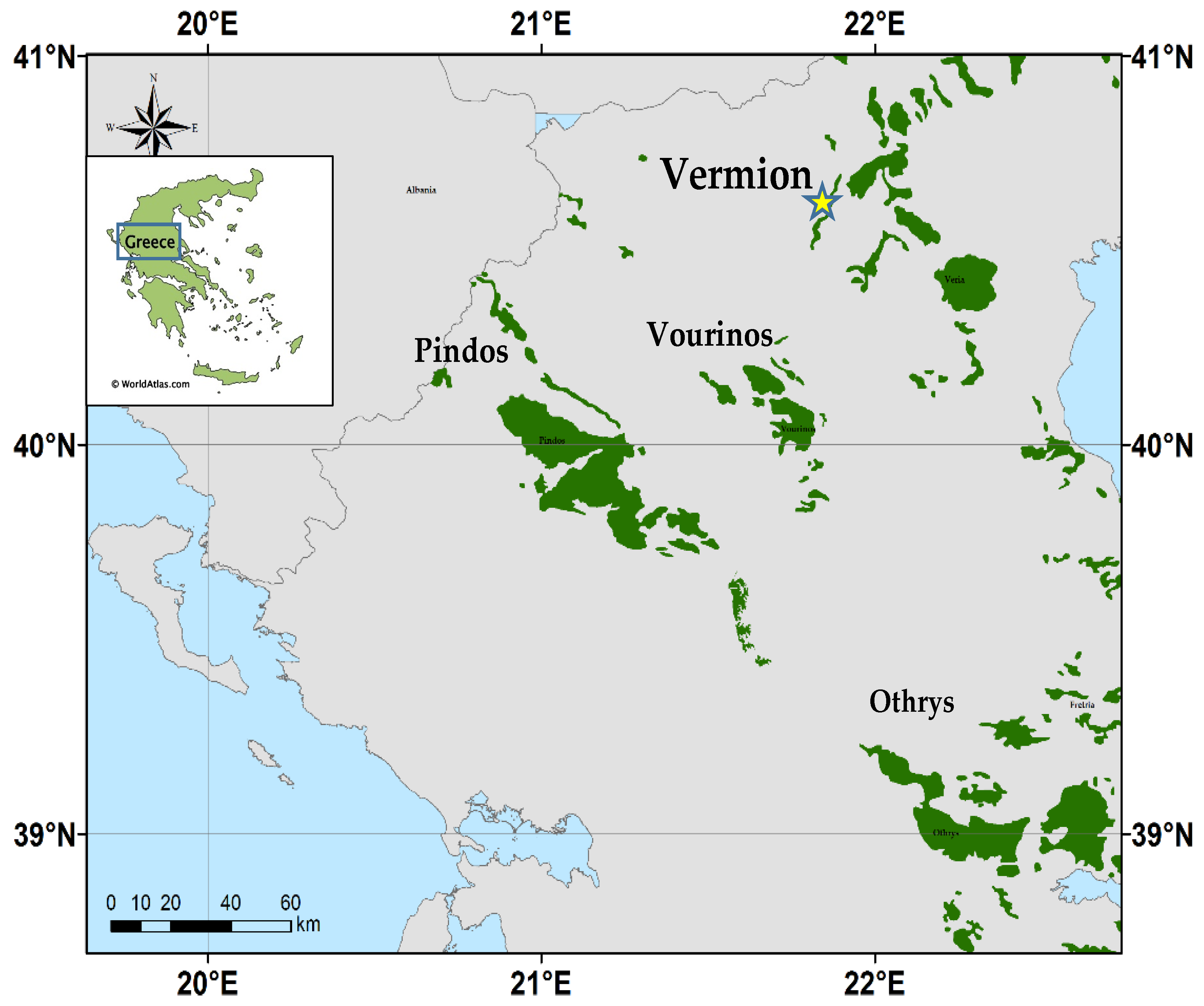
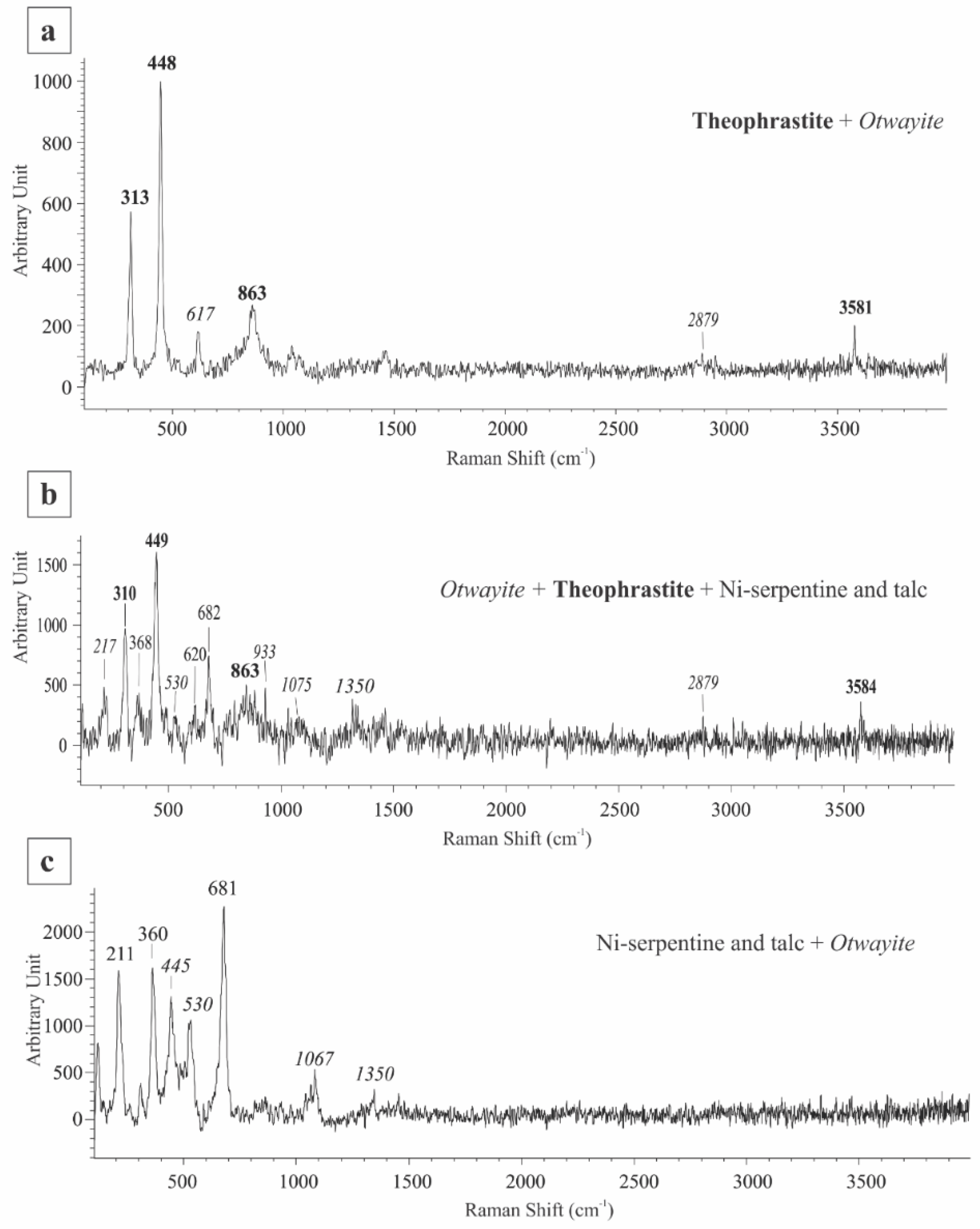
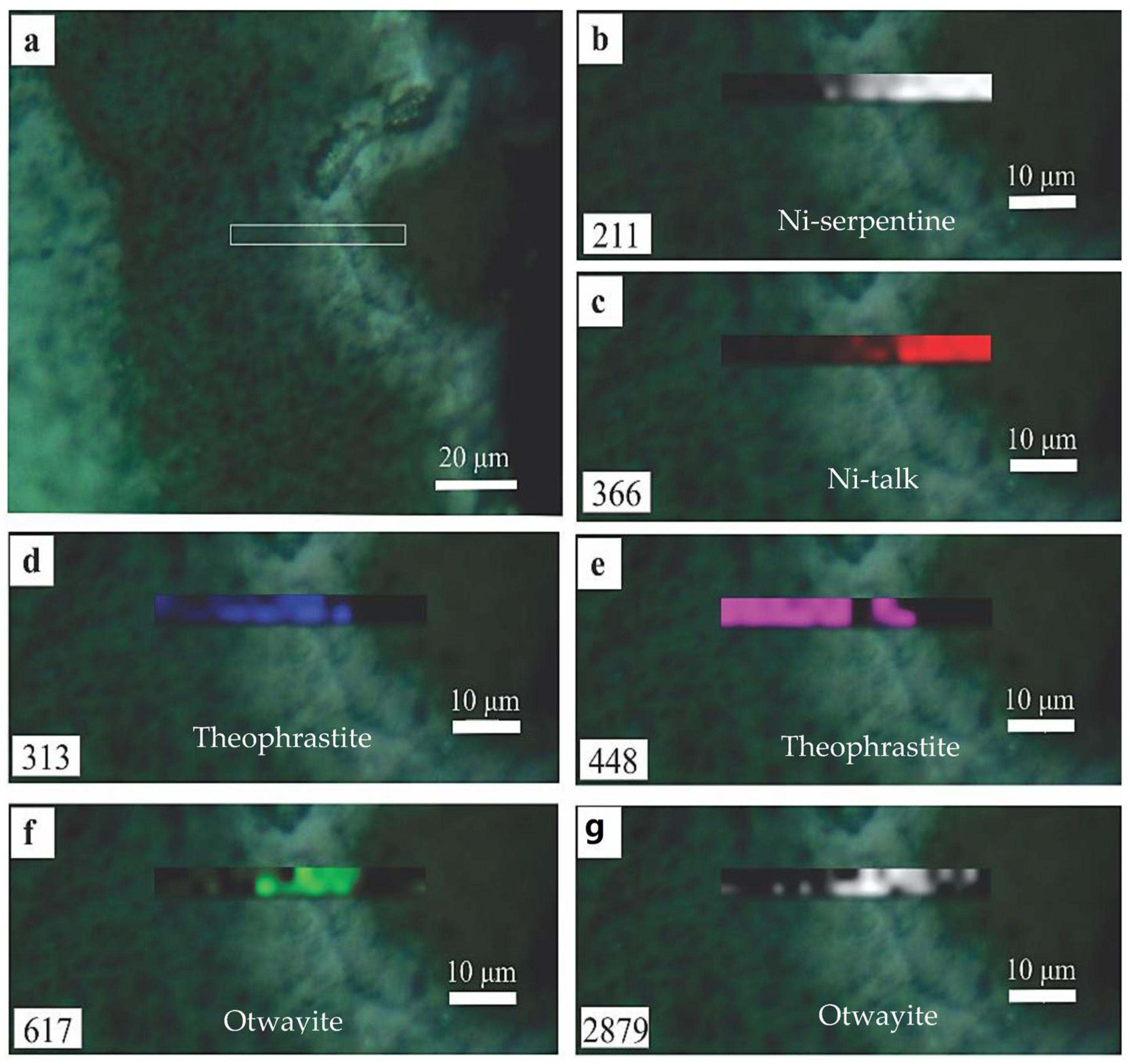
Disclaimer/Publisher’s Note: The statements, opinions and data contained in all publications are solely those of the individual author(s) and contributor(s) and not of MDPI and/or the editor(s). MDPI and/or the editor(s) disclaim responsibility for any injury to people or property resulting from any ideas, methods, instructions or products referred to in the content. |
© 2025 by the authors. Licensee MDPI, Basel, Switzerland. This article is an open access article distributed under the terms and conditions of the Creative Commons Attribution (CC BY) license (https://creativecommons.org/licenses/by/4.0/).
Share and Cite
Economou-Eliopoulos, M.; Kanellopoulos, C.; Papoutsa, A.; Markopoulos, T.; Zaccarini, F.; Perraki, M. Chemistry, Raman Spectroscopy and Micro-Textures of Theophrastite and Other Ni-Minerals from the Vermion Fe-Ni-Laterites, Greece: Genetic Significance. Minerals 2025, 15, 857. https://doi.org/10.3390/min15080857
Economou-Eliopoulos M, Kanellopoulos C, Papoutsa A, Markopoulos T, Zaccarini F, Perraki M. Chemistry, Raman Spectroscopy and Micro-Textures of Theophrastite and Other Ni-Minerals from the Vermion Fe-Ni-Laterites, Greece: Genetic Significance. Minerals. 2025; 15(8):857. https://doi.org/10.3390/min15080857
Chicago/Turabian StyleEconomou-Eliopoulos, Maria, Christos Kanellopoulos, Angeliki Papoutsa, Theodoros Markopoulos, Federica Zaccarini, and Maria Perraki. 2025. "Chemistry, Raman Spectroscopy and Micro-Textures of Theophrastite and Other Ni-Minerals from the Vermion Fe-Ni-Laterites, Greece: Genetic Significance" Minerals 15, no. 8: 857. https://doi.org/10.3390/min15080857
APA StyleEconomou-Eliopoulos, M., Kanellopoulos, C., Papoutsa, A., Markopoulos, T., Zaccarini, F., & Perraki, M. (2025). Chemistry, Raman Spectroscopy and Micro-Textures of Theophrastite and Other Ni-Minerals from the Vermion Fe-Ni-Laterites, Greece: Genetic Significance. Minerals, 15(8), 857. https://doi.org/10.3390/min15080857








